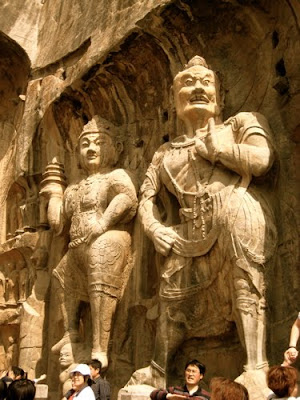Our school provided a guided trip to Luoyang and Zhengzhou down in Henan Province. The whole trip, including admission, food, and transportation, cost a cool 500 RMB (that's less than 80 USD, folks!) so I took advantage of the opportunity to see more of China.
After a pleasant overnight train trip, we arrived in Luoyang at 6:30 am and were off to the Longmen Grottoes. The word "grottoes" conjured up thoughts of the Playboy Mansion or peg-legged pirates, but this couldn't be further from. Sadly, our fairly useless guide didn't tell us much about the history of Longmen, but we gathered what information we could from the
The grottoes were carved around 490 BC and are mostly in tact today (aside some of the factitious natural erosion). The detail that remains is pretty incredible.
A wall of tiny little Buddhas
These little caves are also filled with carved Buddhas and statues.
These giant Buddhas are the main attraction. You can see them compared to the people standing below for size reference. They are HUGE! Again, the detail is amazing and there are amazing carvings in the walls and to the sides of these giant suckers.
Being that it was a major (albeit short) holiday, all the major landmarks in China were flooded with tourists. People back home complain about crowds at Disneyland on a Saturday in the summer. That's China on any given Friday. I don't think I've ever grown to enjoy the insane crowds in China, but I think my tolerance for them has certainly improved.
A sea of black hair, sun umbrellas, and tourist groups.
The ants go marching one by one, hurrah! Hurrah!
Despite the crowds, I was still able to find a few moments of solitude and quite in the midst of the tourism madness.
After our rushed tour through the grottoes, it was back on the bus with our useless tour guide for an hour-long journey to Shaolin Temple nestled in the foothills of the famous Song Mountain- a gorgeous mountain range surrounded by green. And yes, Shaolin as in Shaolin Soccer.
But more importantly, Shaolin as in the birthplace of Kung Fu (Gongfu, for any of your die-hard Mandarin speakers). A little-known fact is that much of my parents' early courtship was marked by frequent trips to the local Kung Fu theater to watch old Bruce Lee movies. Then- according to my mom- my dad would romantically whisk my mom back to his apartment and put the moves on. No, not those moves. He would show off his mad nunchuck skills. Yes, my parents really are that cool.
So with that in my history, I was actually really excited to tour the birthplace of Kung Fu. Unfortunately, a LOT of other people were, too.
The line of cars leading up to the parking lot for the Shaolin Temple. There's nothing scarier than a crowd of Chinese people than a crowd of Chinese people behind the wheel!
After some time in the car, we made it into Shaolin Temple. The temple itself was not spectacular- once you've seen one Buddhist temple in China, you've pretty much seen them all until you head up to Tibet. But the most interesting part of Shaolin was the Pagoda Garden, which puts our American cemeteries to shame.
An interesting Buddhism tidbit that I learned was that you can learn a lot of information about a monk from his pagoda. Since Buddhism runs on the merits/demerits system, the more merits a man has, the higher his pagoda is. This doesn't come as a surprise to most, but what was surprising was that you can earn a huge amount of merits if you raise money for your temple or for Buddhism in general. The monks won't keep the money to themselves, but if you happen to garner a larger amount of donations or contributions to Buddhism during your life, you might end up with a few more levels on your pagoda when you pass on.
There were also a lot of monks (some perhaps more authentic than others) peddling goods like prayer beads, and one old man who was selling these interesting herbs.
A doorway at Shaolin Temple.
Rice paddies in the surrounding area with the Song Mountain in the background.
Of course, you can't go to the birthplace of Kung Fu without taking in a Kung Fu show. Because of the traffic, we missed the last show at the temple, but our guide took us to one of the many surrounding Kung Fu academies near the temple. We actually went to Bruce Lee's Kung Fu academy and saw some of the students perform Kung Fu.
Our guide said that the school probably has 4000-5000 students and costs at least 100,000 RMB per year! This is a fairly typical Chinese practice. Parents will enroll their children into a school specializing in one skill, and they become experts in that skill at a very young age. This also explains why China is kicking major butt at a lot of Olympic events like gymnastics, diving, and figure skating-- they've been doing it since they were popped out of the womb!
Why settle for one Bruce Lee when you could have thousands upon thousands of pocket-sized Bruce Lees?






















No comments:
Post a Comment